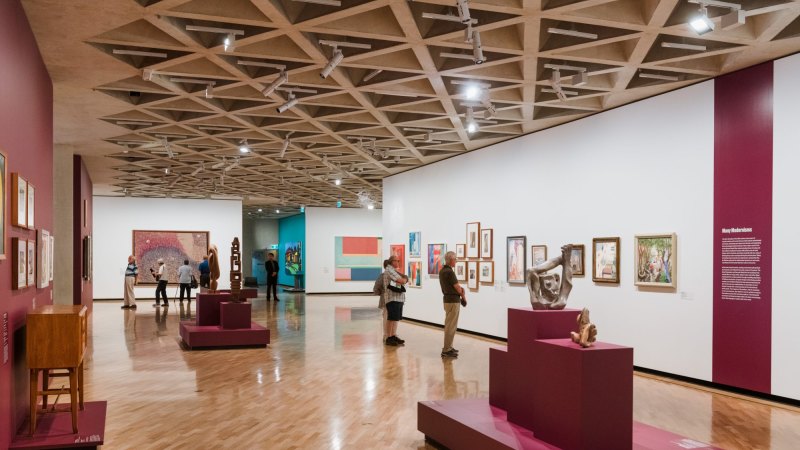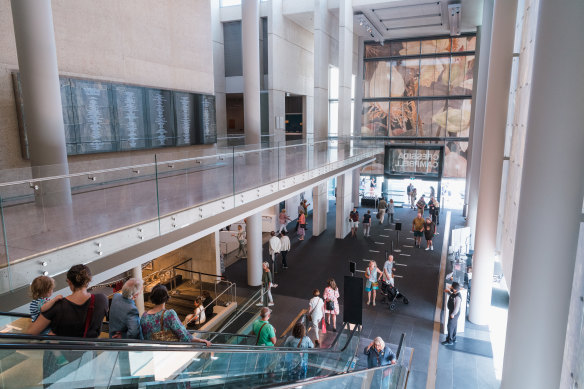Save articles for later
Add articles to your saved list and come back to them any time.
The National Gallery of Australia has put on ice its major winter show after extending the reporting deadline of an independent review convened to investigate the provenance of the exhibition’s 28 Indigenous artworks.
Billed as one of the largest and most significant First Nations community-driven art projects to have ever been developed at the Canberra gallery, Ngura Pulka – Epic Country, exclusively features works by artists from the APY Art Centre Collective, based in remote South Australia.
The National Gallery of Australia has delayed its winter showcase of Indigenous art. Credit: James Brickwood
The collective is vigorously defending claims, first raised in The Australian, that white studio assistants had interfered in the making of Indigenous works to make them more “collectible”.
The collective’s directors immediately welcomed the gallery’s decision to ensure the review and works were afforded the most rigorous examination possible. “Light is always the best defence to darkness,” they said.
“Given recent accusations that we believe are without merit, we welcome the most rigorous and robust reviews of the work. Knowing the truth and authenticity of the works and having an abundance of pride in this project and every facet of our important program and the business we’ve built, we are content to wait for the independent panel to make their findings.”
Ngura Pulka will now be rescheduled for next year, leaving a gaping hole in the gallery’s exhibition program.
The postponement is likely to result in a financial hit to the gallery’s exhibition revenues this year but in a brief statement issued on Wednesday the gallery’s governing council said the independent review panel required more time to fully complete their work.
It also cited the decision of the Federal, South Australian and Northern Territory governments to jointly fund an inquiry led by the collective’s principal funder, the South Australian government. Terms of reference are yet to be officially announced.
“The National Gallery will work with the artists and Anangu Pitjantjatjara Yankunytjatjara (APY) community leaders in relation to the exhibition and will await the outcome of both reviews,” it said.
“The National Gallery is committed to continuing to work with APY Lands artists and supporting their ground-breaking work.”
Melbourne barrister Colin Golvan and Sydney lawyer, Shane Simpson, both experts in copyright law, had originally been given five weeks by the gallery to determine if exhibition paintings could be “properly be described as having been made under the creative control of the persons named as the artists”. Interviews have been taking place with various interested parties including the artists themselves in the last several weeks.
The use of studio artists is a common if largely unspoken practice in the art world with some of the world’s most celebrated artists Salvador Dali, Jeff Koons, and Andy Warhol using technicians to create some of their famous works.
“Michelangelo had assistance in painting The Sistine Chapel,” federal arts minister Tony Burke said recently. “No one said it wasn’t his work.”
But the board of directors of Desart, the peak body representing more than 30 Central Australian Aboriginal Art centres, has reiterated that Tjupurka, the Aboriginal name given to the license to paint ancient cultural stories exclusively passed on from one generation to another, is not “for white people to interfere with”.
The collective said artworks celebrated in Ngura Pulka were examples of paintings that celebrated artistic excellence and cultural integrity underpinned with deep reverence and respect for Tjukurpa handed on by the ancestors.
Separately, peak art centre bodies met twice last month about the allegations. A representative for the Australia Council said there were no plans to develop separate guidelines around the use of assistants at this time.
Existing protocols for using First Nations Cultural and Intellectual Property in the arts clearly set out the legal, ethical, and moral considerations for the use of Indigenous cultural material in arts and cultural projects.
It welcomed the joint government investigation and would assist in any way, “as appropriate”.
APY Art Centre Collective is a group of like-minded art centres from a region the size of Iceland, that has become a dominant force in the Indigenous art world over the last decade. Four of 40 finalists in this year’s Wynne, Australia’s oldest art prize, were artists from the collective, including its winner Zaachariah Fielding who beat the sentimental favourite, John Olsen.
Under the watch of its director Skye O’Meara, the collective has established its own galleries in Sydney, Melbourne and Adelaide and had been a strong critic of unscrupulous practices by some middlemen during last year’s Productivity Commission inquiry into fake Indigenous arts and crafts.
Sydney Morning Herald subscribers can enjoy 2-for-1 tickets* to the Archibald, Wynne and Sulman Prizes exhibition at the Art Gallery of New South Wales during June 2023. Click here for more details.
The Booklist is a weekly newsletter for book lovers from books editor Jason Steger. Get it delivered every Friday.
Most Viewed in Culture
From our partners
Source: Read Full Article

